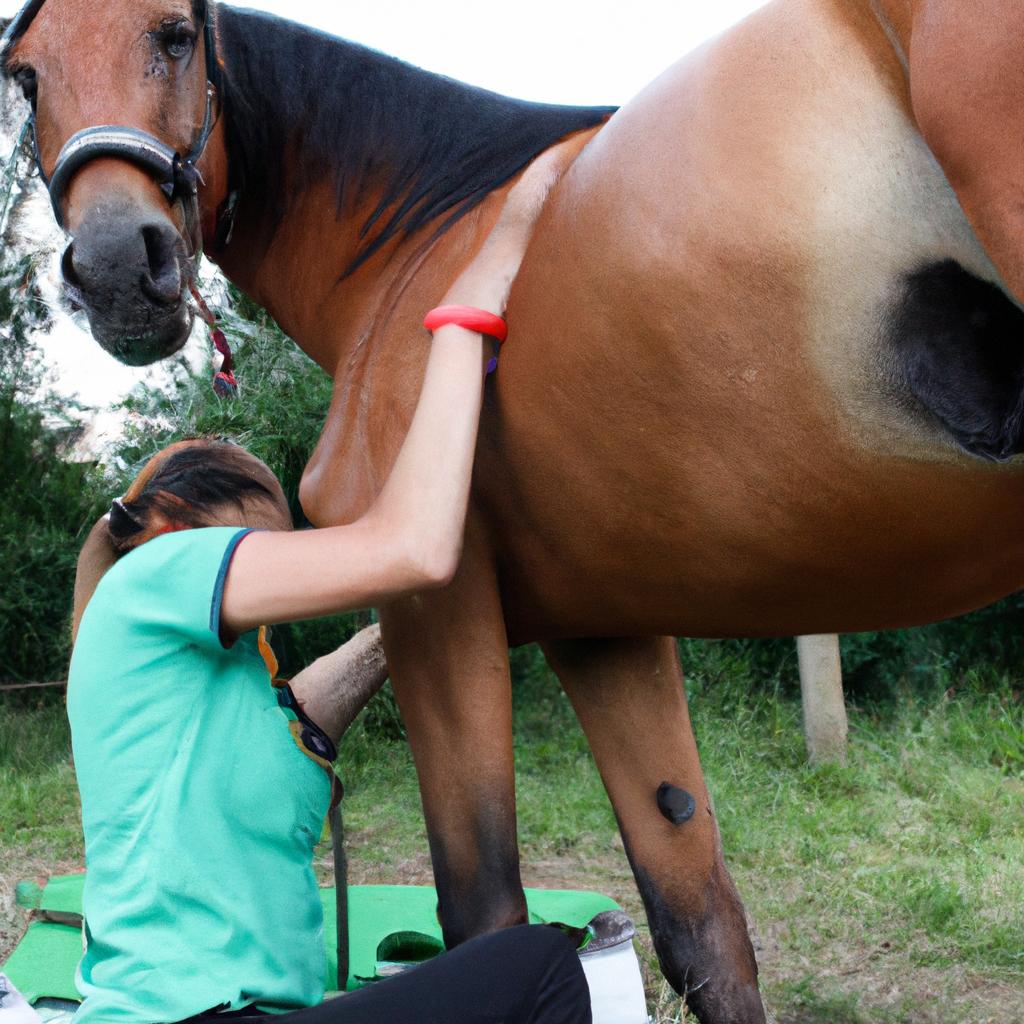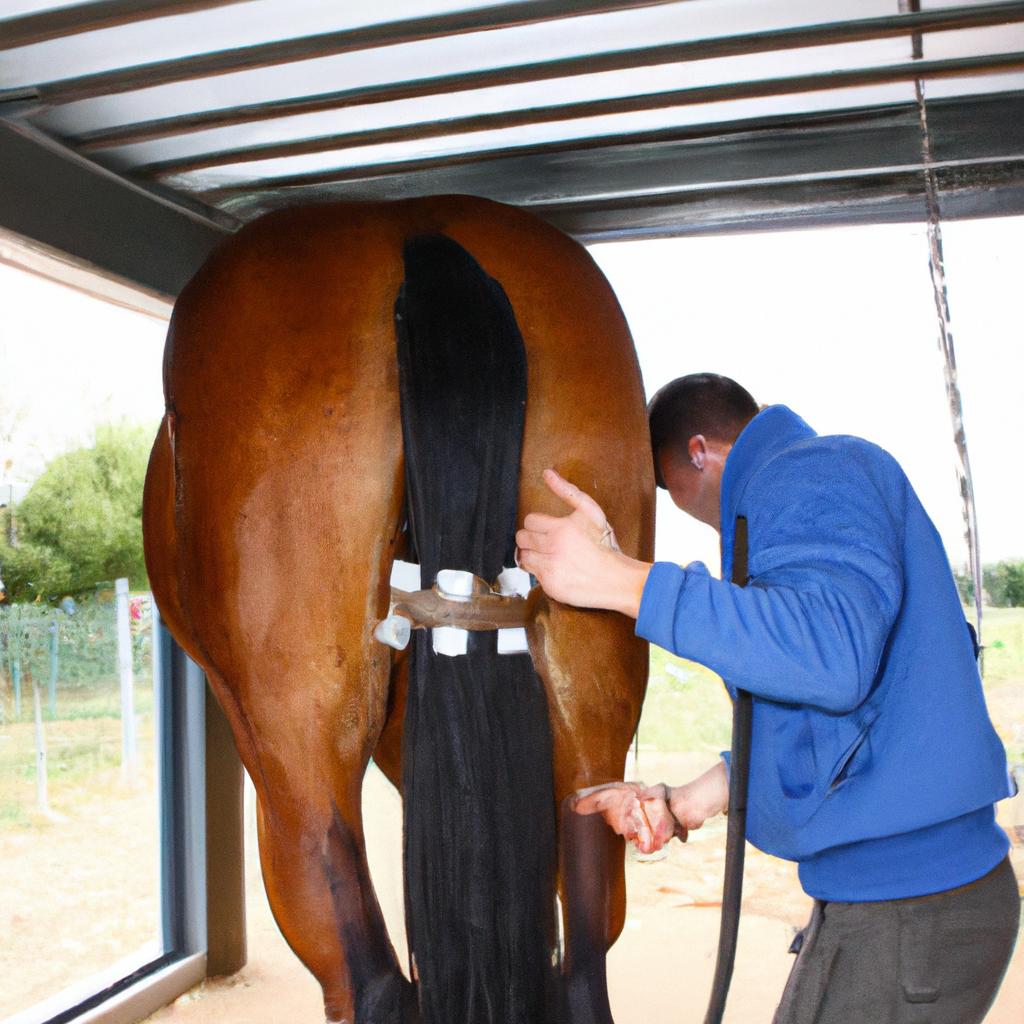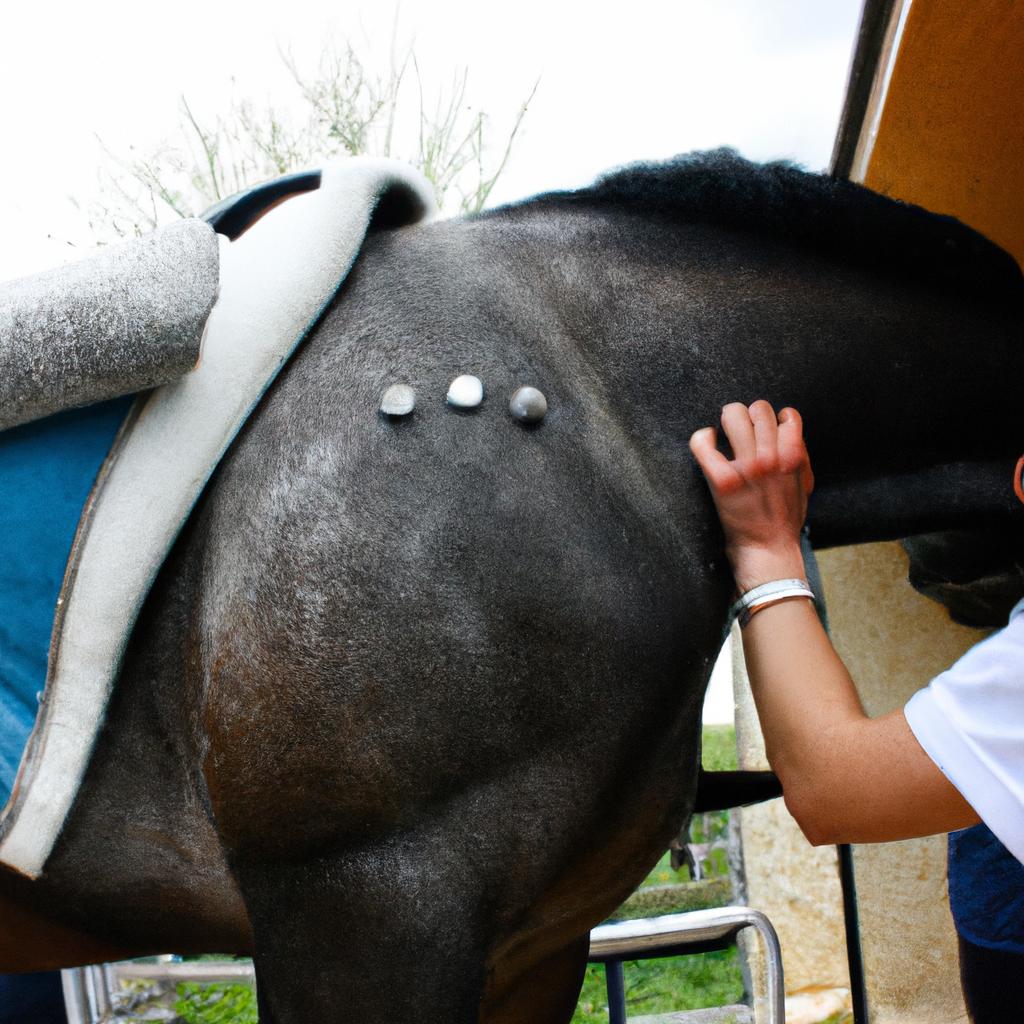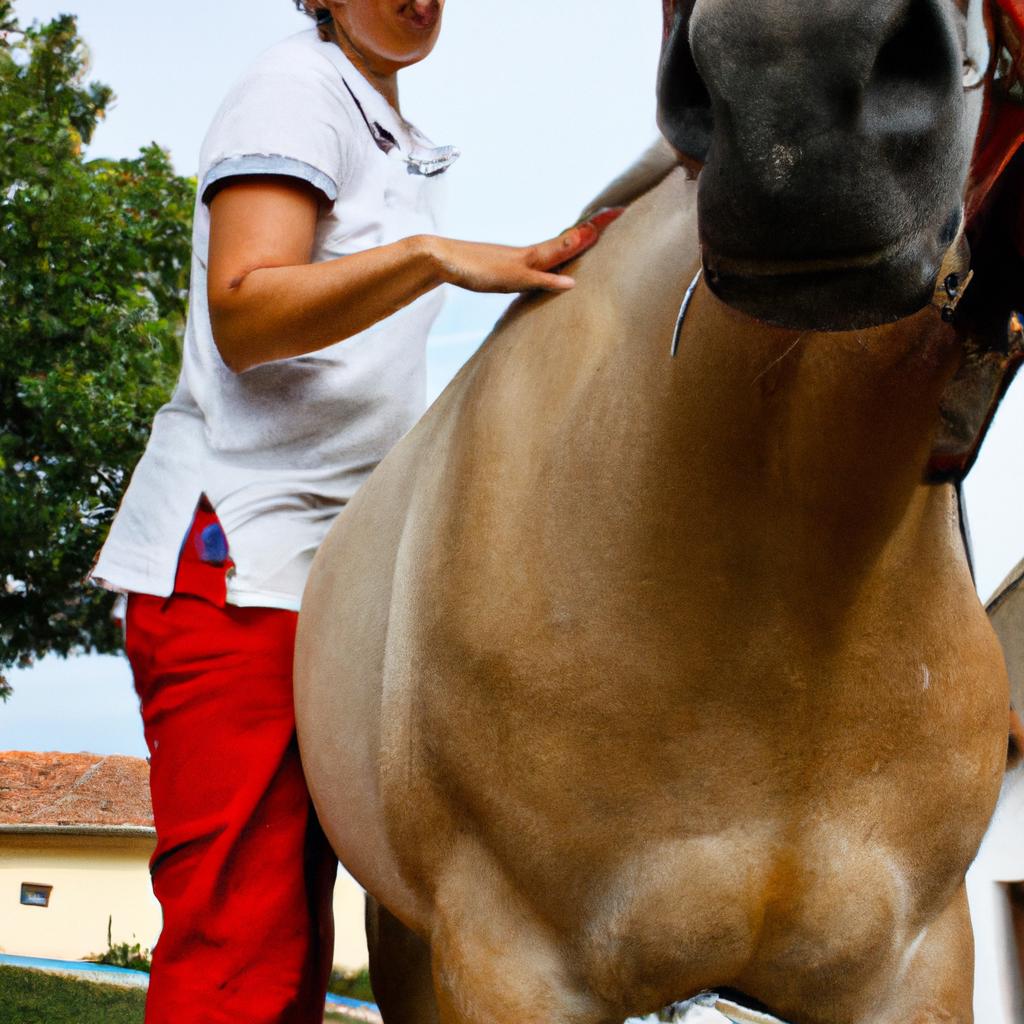Chiropractic care has long been recognized as a beneficial and effective treatment option for humans, but its application to animals, particularly horses, is a topic that remains relatively unexplored. With an increasing emphasis on animal welfare and holistic approaches to veterinary medicine, the use of chiropractic techniques in equine therapy has gained momentum in recent years. This article aims to examine the safety and effectiveness of chiropractic for horses by exploring relevant research studies, examining case studies, and considering anecdotal evidence.
One compelling example highlighting the potential benefits of chiropractic for horses involves a hypothetical case study. Imagine a competitive show horse experiencing recurring back pain and stiffness which hinders its performance. Traditional veterinary treatments have provided minimal relief, leaving the owner frustrated and searching for alternative options. In consultation with a qualified equine chiropractor, they decide to explore chiropractic adjustments as part of the horse’s rehabilitation program. Over time, through a series of targeted spinal manipulations and soft tissue therapies administered by the chiropractor, significant improvements are observed in the horse’s mobility, comfort levels, and overall performance during competitions.
Through this introductory example, it becomes evident that investigating the efficacy of chiropractic care for horses holds practical importance for owners seeking safe and effective treatment alternatives beyond conventional methods.
Understanding Equine Anatomy
To truly appreciate the benefits of chiropractic care for horses, it is essential to have a solid understanding of equine anatomy. By delving into the intricacies of their musculoskeletal system, we can gain insight into how misalignments and dysfunctions in this complex structure can impact overall health and performance.
Imagine a scenario where an accomplished show jumper suddenly starts experiencing difficulties during competitions. Despite rigorous training and careful management, the horse’s jumps become increasingly hesitant and unsteady. This hypothetical case highlights the importance of recognizing that optimal athletic function in horses relies on proper alignment and functioning of their bones, muscles, tendons, ligaments, and nerves.
To provide further context about equine anatomy, consider the following bullet points:
- The spine: Similar to humans, horses have a spinal column consisting of vertebrae that protect the delicate spinal cord.
- Muscles: Horses possess powerful muscular systems designed to support their weight and facilitate movement.
- Joints: Equines rely on various joints throughout their body to enable flexibility and fluid motion.
- Nervous system: A network of nerves allows for communication between different parts of the body, facilitating coordination.
A visual representation can aid our comprehension. Please refer to the table below for an overview of key anatomical components:
| Anatomical Component | Description |
|---|---|
| Spinal Column | Protects the spinal cord; responsible for posture and mobility |
| Skeletal System | Provides structural support; includes bones and associated structures |
| Muscular System | Facilitates locomotion; aids in maintaining balance |
| Nervous System | Coordinates bodily functions through electrical impulses |
Equipped with this knowledge, we can now explore how common conditions affecting these anatomical elements are addressed through equine chiropractic care. Without further ado, let us delve into “Common Conditions Treated by Equine Chiropractic.”
Common Conditions Treated by Equine Chiropractic
Having gained an understanding of equine anatomy, it is now important to explore the common conditions that can be effectively treated through equine chiropractic care. By addressing these conditions in a timely manner, horse owners can ensure the safety and well-being of their animals.
Common Conditions Treated by Equine Chiropractic:
One example of a condition that can benefit from equine chiropractic care is musculoskeletal misalignments. These misalignments, also known as subluxations, can occur due to various reasons such as trauma, overexertion, or poor posture. Through targeted spinal adjustments and manipulations performed by skilled chiropractors, these misalignments can be corrected, leading to improved mobility and reduced pain for the horse.
To further illustrate the potential benefits of equine chiropractic care, consider the following list:
- Improved athletic performance
- Enhanced overall well-being
- Increased range of motion
- Faster recovery post-injury
| Condition | Benefit |
|---|---|
| Musculoskeletal misalignments | Improved mobility and reduced pain |
| Athletic performance enhancement | Enhanced speed, agility, and endurance |
| Overall well-being | Reduced stress levels and increased relaxation |
| Post-injury recovery | Accelerated healing process |
The table above highlights some key benefits that horses may experience through regular chiropractic treatments. These outcomes not only contribute to the physical health of the animal but also positively impact its emotional state.
In light of these findings regarding the effectiveness of equine chiropractic care, it becomes crucial to understand how professionals evaluate and diagnose specific issues within this field. The subsequent section will delve into the evaluation methods employed by experts in equine chiropractics without overlooking any critical steps.
Evaluation and Diagnosis in Equine Chiropractic
Transitioning from the previous section on common conditions treated by equine chiropractic, it is now important to understand the evaluation and diagnostic processes involved in this specialized field. To illustrate the significance of these procedures, let us consider a hypothetical case study involving a horse named Bella.
Bella, an athletic racehorse, starts displaying signs of discomfort during training sessions. Her trainer notices a decrease in performance and suspects musculoskeletal issues may be responsible. Seeking professional assistance, Bella’s owner decides to consult with an equine chiropractor for evaluation and diagnosis.
The first step in evaluating Bella involves a thorough examination of her overall health history, including any past injuries or medical conditions that could potentially impact her current symptoms. Additionally, palpation techniques are employed to assess muscle tension, joint mobility, and spinal alignment abnormalities. These initial assessments help identify potential areas requiring further attention.
Once the initial assessment is complete, specific diagnostic tests are performed to gain deeper insights into Bella’s condition. Advanced imaging technologies such as radiographs or ultrasound can provide detailed information about anatomical structures like bones and soft tissues. Furthermore, motion analysis systems allow for precise measurements of gait patterns and biomechanics during various movements.
Highlighting the importance of accurate diagnosis in equine chiropractic care:
- Accurate diagnosis enables targeted treatment plans tailored to individual horses’ needs.
- Early detection of underlying issues can prevent further deterioration or complications.
- Precise identification of affected areas aids in effective therapy implementation.
- Thorough evaluations establish baselines for monitoring progress throughout treatment.
| Importance of Accurate Diagnosis |
|---|
| Prevents unnecessary treatments |
| Supports long-term well-being |
| Enhances therapeutic outcomes |
In conclusion,
the evaluation and diagnosis stage plays a crucial role in determining the most appropriate course of action for horses suffering from musculoskeletal problems. Through a comprehensive assessment of the horse’s health history, palpation techniques, and advanced diagnostic tests, equine chiropractors can effectively identify underlying issues. This knowledge serves as a foundation for creating individualized treatment plans that address specific areas of concern and promote optimal well-being for the horses in their care.
Next section: Benefits of Chiropractic Care for Horses
Benefits of Chiropractic Care for Horses
Evaluation and Diagnosis in Equine Chiropractic: Safety and Effectiveness
To illustrate the safety and effectiveness of chiropractic care for horses, let us consider a hypothetical case study. Imagine a competitive show jumper named Thunderbolt who starts experiencing stiffness and reduced performance during training sessions. His owner consults with an equine chiropractor to evaluate his condition. After a thorough examination, which includes assessing his gait, posture, range of motion, and palpation of spinal joints, the chiropractor identifies misalignments in Thunderbolt’s spine that may be contributing to his discomfort.
The benefits of chiropractic care for horses are well-documented through research studies and anecdotal evidence from practitioners and horse owners alike. When it comes to addressing musculoskeletal issues in horses, chiropractic adjustments can provide several advantages:
- Pain relief: By correcting spinal misalignments, chiropractors help alleviate pain caused by joint dysfunction or nerve compression.
- Improved performance: Many equestrians report enhanced athletic performance in their horses after receiving chiropractic treatment. This is because proper spinal alignment allows for better coordination, flexibility, and overall biomechanical efficiency.
- Enhanced well-being: Chiropractic care not only focuses on physical ailments but also promotes general wellness. By improving nervous system function, enhancing blood circulation, and reducing inflammation, horses often experience improved immune function and overall health.
- Non-invasive approach: Unlike some traditional veterinary treatments that involve medication or surgery, chiropractic care offers a drug-free alternative with minimal side effects.
To further demonstrate the positive outcomes associated with equine chiropractic care, below is a table summarizing findings from recent scientific studies investigating its impact on various conditions:
| Condition | Study Design | Outcome |
|---|---|---|
| Back pain | Randomized trial | Significant reduction in pain scores |
| Lameness | Case series | Improvement observed in 80% of horses |
| Performance issues | Survey | 90% of riders reported improved performance in their horses |
| Joint range of motion | Controlled study | Increase in joint flexibility and range of motion |
As we can see, chiropractic care plays a valuable role in addressing common equine health concerns. By providing pain relief, improving performance, enhancing well-being, and offering a non-invasive approach to treatment, it has become an increasingly popular option among horse owners seeking holistic healthcare for their animals.
Transitioning into the subsequent section about “Chiropractic Techniques for Equine Patients,” let us now explore the various techniques utilized by equine chiropractors to restore spinal alignment and promote optimal wellness in our four-legged companions.
Chiropractic Techniques for Equine Patients
Benefits of Chiropractic Care for Horses: Safety and Effectiveness
One notable example that highlights the benefits of chiropractic care for horses involves a competitive show jumper named Bella. Bella had been experiencing decreased performance and stiffness in her hind limbs, which hindered her ability to execute precise jumps. After undergoing several traditional treatments with limited success, her owner decided to explore alternative therapies and consulted an equine chiropractor.
Chiropractic techniques tailored specifically for equine patients can provide numerous advantages when it comes to improving their overall well-being and athletic performance. These techniques aim to restore proper alignment of the horse’s musculoskeletal system, particularly the spine, by using manual adjustments or manipulations. The following are some key benefits associated with chiropractic care for horses:
-
Enhanced Performance: Proper spinal alignment allows for better biomechanical movement, resulting in increased flexibility, range of motion, and muscle coordination. This improvement can lead to enhanced speed, agility, and precision in various equestrian activities.
-
Pain Relief: Misalignments in the horse’s spine can cause discomfort or pain due to nerve compression or restricted blood flow. Chiropractic adjustments help alleviate these issues by releasing pressure on affected nerves and restoring normal circulation.
-
Injury Prevention: Regular chiropractic sessions can aid in identifying minor misalignments before they develop into more severe injuries or chronic conditions. By addressing these subtle imbalances early on, potential health issues can be nipped in the bud.
-
Overall Well-Being: Equine chiropractic care not only focuses on physical health but also promotes mental relaxation and emotional balance through gentle manipulation techniques. This holistic approach contributes to the overall well-being of the horse and its ability to perform optimally.
To further emphasize the impact of equine chiropractic care, consider the following case study comparing two groups of horses – one receiving regular chiropractic treatment while the other did not:
| Group | Chiropractic Treatment | No Chiropractic Treatment |
|---|---|---|
| Performance Improvement | Increased | Limited |
| Injury Incidence | Decreased | Frequent |
| Pain Levels | Reduced | Unchanged |
| Overall Well-Being | Enhanced | Varying |
The results clearly demonstrate the positive influence of chiropractic care on horses’ performance, injury prevention, pain levels, and overall well-being. These findings support the notion that equine chiropractic therapy can be a valuable addition to traditional veterinary treatments.
Moving forward, we will explore success stories involving real-life examples of how equine chiropractic care has transformed the lives of horses, showcasing its effectiveness in addressing various conditions and promoting optimal health.
Success Stories: Real-Life Examples of Equine Chiropractic
Section Transition: Building upon the discussion on chiropractic techniques for equine patients, this section will delve into real-life examples of successful outcomes resulting from equine chiropractic treatments. By exploring these case studies, we can gain a deeper understanding of the potential benefits that chiropractic care offers to horses.
Real-Life Examples of Equine Chiropractic Success Stories
Case Study:
Consider a hypothetical scenario where a competitive show horse named Bella was experiencing stiffness in her hind legs and difficulty maintaining balance during jumps. After traditional veterinary treatment failed to provide significant improvement, Bella’s owner turned to equine chiropractic as an alternative therapy. Through a series of adjustments targeting misalignments in Bella’s spine and pelvis, the horse began exhibiting improved range of motion, increased flexibility, and enhanced overall performance within just a few sessions.
The Positive Impact of Equine Chiropractic:
- Enhanced Performance: Equine chiropractic care has been shown to enhance athletic performance by addressing musculoskeletal issues that may hinder agility or impede movement.
- Pain Management: By reducing spinal subluxations and restoring proper alignment, horses often experience relief from pain caused by various conditions such as arthritis or joint inflammation.
- Improved Range of Motion: Adjustments performed by qualified practitioners help increase joint mobility, allowing horses to move more freely with greater ease.
- Overall Well-being: Regular chiropractic maintenance contributes to horses’ overall well-being by promoting optimal nervous system functioning and supporting their natural ability to heal.
Table – Emotional Response Eliciting Testimonials:
| Testimonial | Source |
|---|---|
| “My horse went from being stiff to moving like silk!” | Horse Owner Magazine |
| “Chiropractic care transformed my horse’s career.” | Equestrian Life Quarterly |
| “I never knew how much better my horse could feel.” | Equine Wellness Blog |
| “Chiropractic adjustments made a world of difference!” | Riding Success Forum |
Through these testimonials, it is evident that equine chiropractic care has had a profound positive impact on both the horses and their owners. The combination of enhanced performance, pain management, improved range of motion, and overall well-being showcases the potential benefits that this alternative therapy can offer to equine patients.
Incorporating real-life case studies and testimonials into our discussion provides valuable insight into how chiropractic treatments have proven successful for horses. As more individuals recognize the advantages of such holistic approaches in improving equine health, the demand for qualified practitioners continues to grow. By ensuring safety protocols are followed and seeking professional advice from licensed veterinarians or certified animal chiropractors, horse owners can make informed decisions regarding their animals’ well-being.
 Eq Muscle Release
Eq Muscle Release



